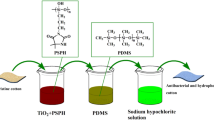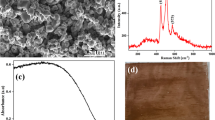Abstract
Two generations of poly (propylene imine) dendrimer with amino terminated groups (G2- and G5-PPI-NH2) were grafted on cotton cellulose fabric using cross linking agents (citric or glutaric acids). Fourier transform infrared (FTIR) spectroscopy identified ester groups which were formed between hydroxyl groups of the cotton fabric and carboxylic groups of the cross linking agents. Also, attenuated total reflectance-FTIR (ATR-FTIR) analysis confirmed formation of amide groups between the carboxylic groups of the cross linking agents and the amino end groups of the dendrimers. Nitrogen content (N-content) analysis revealed the presence of the dendrimers on the cotton fabric even after 5 washing cycles. In order to study the dispersion of the PPI dendrimers on the surface of the cotton fabric, field emission scanning electron microscopy (FE-SEM) was performed. The particle size distribution of the G2- and G5-PPI-NH2 aqueous solutions was also determined by dynamic light scattering (DLS) analysis. Antimicrobial activity of the PPI dendrimer aqueous solutions and the cotton cellulose fabric grafted with the dendrimers was evaluated both quantitatively and qualitatively against Gram-positive bacterium (Staphylococcus aureus), Gram-negative bacteria (Pseudomonas aeruginosa and Escherichia coli) and fungus (Candida albicans). The dendrimer grafted cotton cellulose fabric exhibited a 99 % reduction in bacterial counts against S. aureus, E. coli and C. albicans. The antimicrobial activities of the grafted cotton cellulose fabric with the PPI dendrimers were maintained even after 5 washing cycles.







Similar content being viewed by others

References
Abedi D, Mortazavi SM, Mehrizi MK, Feiz M (2008) Antimicrobial properties of acrylic fabrics dyed with direct dye and a copper salt. Text Res J 78:311–319
Boas U, Christensen JB, Heegaard PMH (2006) Dendrimers in medicine and biotechnology: New molecular tools. RSC Publishing, Cambridge, pp 28–59
Brabander-van De, den Berg EMM, Meijer EW (1993) Poly (propylene imine) dendrimers: large-scale synthesis by heterogeneously catalyzed hydrogenations. Angew Chem Int Ed 32:1308–1311
Chen CZ, Cooper SL (2000) Recent advances in antimicrobial dendrimers. Adv Mater 12:843–846
El-tahlawy KF, El-bendary MA, Elhendawy AG, Hudson SM (2005) The antimicrobial activity of cotton fabrics treated with different cross linking agents and chitosan. Carbohydr Polym 60:421–430
Frechet JMJ (1994) Functional polymers and dendrimers: reactivity, molecular architecture, and interfacial energy. Science 263:1710–1715
Frechet JMJ, Tomalia DA (2001) Dendrimers and other dendritic polymers. Wiley, New York
Froehling PE (2001) Dendrimers and dyes-a review. Dyes and Pig 48:187–195
Gao Y, Cranston R (2008) Recent advances in antimicrobial treatments of textiles. Text Res J 78:60–72
Gao Y, Cranston R (2010) An effective antimicrobial treatment for wool using polyhexamethylene biguanide as the biocide, part 2: further characterizations of the fabrics. J App Poly Sci 117:2882–2887
Genas M (1951) Hypophosphorous acid and hypophosphites as catalyzers of condensation of monoamino monocarboxylic acids. US Patent 2 564 001, 14 August
Ghosh S, Yadav S, Vasanthan N, Sekosan G (2010) A study of antimicrobial property of textile fabric treated with modified dendrimers. J Appl Polym Sci 115:716–722
Gooßen LJ, Ohlmann DM, Lange PP (2009) The thermal amidation of carboxylic acids revisited. Synthesis 1:160–164
Gordon S, Hsieh YL (2007) Cotton: science and technology. Woodhead, Cambridge
Kabanov VA, Zezin AB, Rogacheva VB, Gulyaeva ZhG, Zansochova MF, Joosten JGH, Brackman J (1998) Polyelectrolyte behavior of astramol poly (propylene imine) dendrimers. Macromol 31:5142–5144
Kanazawa A, Ikeda T, Endo T (1993) Polymeric phosphonium salts as a novel class of cationic biocides. III. Immobilization of phosphonium salts by surface photografting and antibacterial activity of the surface-treated polymer films. J Polym Sci Polym Chem 31:1467–1472
Kawabata A, Taylor JA (2007) The effect of reactive dyes upon the uptake and antibacterial efficacy of poly (hexamethylene biguanide) on cotton. Part 3: reduction in the antibacterial efficacy of poly (hexamethylene biguanide) on cotton, dyed with bis (mono chlorotriazinyl) reactive dyes. Carbohydr Polym 67:375–389
Kim CH, Kim SY, Choi KS (1997) Synthesis and antibacterial activity of water-soluble chitin derivatives. Polym Adv Tech 8:319–325
Kitkulnumchai Y, Ajavakom A, Sukwattanasinitt M (2008) Treatment of oxidized cellulose fabric with chitosan and its surface activity towards anionic reactive dyes. Cellulose 15:599–608
Kuo JHS, Jan MS, Lin YL (2007) Interactions between U-937 human macrophages and poly (propylene imine) dendrimers. J Control Releas 120:51–59
Lim SH, Hudson SM (2004) Synthesis and antimicrobial activity of a water soluble chitosan derivative with a fiber reactive group. Carbohydr Res 339:313–319
Mammen M, Choi SK, Whitesides GM (1998) Polyvalent interactions in biological systems: implications for design and use of multivalent ligands and inhibitors. Angew Chem Int Ed 37:2754–2794
McAuley KB, Zheng W, Marchildon EK, Yao KZ (2007) Melt-phase nylon 612 polycondensation kinetics: effects of sodium hypophosphite catalyst. Canadian J Chem Eng 85:180–187
Meijer EW, Jansen JFGA, De Brabander-van den Berg EMM (1994) Encapsulation of guest molecules into a dendritic box. Science 266:1226–1229
Murray PR, Rosenthal KS, Pfaller MA (2009) Medical microbiology. Mosby Elsevier, Philadelphia
Newkome GR, Moorefield CN, Vogtle F (2001) Dendrimers and dendrons. Concepts, syntheses, applications. Wiley, Weinheim
Orhan M, Kut D, Gunesoglu C (2009) Improving the antibacterial activity of cotton fabrics finished with triclosan by the use of 1,2,3,4-butanetetracarboxylic acid and citric acid. J App Poly Sci 111:1344–1352
Qian L, Guan Y, He B, Xiao H (2008) Modification guanidine polymers: synthesis and antimicrobial mechanism revealed by AFM. Polymer (Guildf) 49:2471–2475
Shateri Khalil-Abad M, Yazdanshenas ME, Nateghi MR (2009) Effect of cationization on adsorption of silver nanoparticles on cotton surfaces and its antibacterial activity. Cellulose 16:1147–1157
Vogtle F, Buhleier E, Wehner W (1978) “Cascade”- and “Nonskid-Chain-like” syntheses of molecular cavity topologies. Synthesis 2:155–158
Welch CM, Andrews BK (1989) Catalysts and processes for formaldehyde-free durable pressing finishing of cotton textiles with poly carboxylic acids. US Patent 4 820 307, 11 April
Wu X, Yang CQ (2008) Flame retardant finishing of cotton fleece fabric: part 3- The combination of maleic acid and sodium hypophosphite. J Fire Sci 26:351–368
Wu X, Yang CQ (2009) Flame retardant finishing of cotton fleece fabric: part IV- Bifunctional carboxylic acids. J Fire Sci 27:431–446
Xiaohong G, Yang CQ (2000) FTIR spectroscopy study of the formation of cyclic anhydride intermediates of polycarboxylic acids catalyzed by sodium hypophosphite. Text Res J 70:64–70
Yang CQ (1991) Characterizing ester cross linkages in cotton cellulose with FT-IR photo acoustic spectroscopy. Textile Res J 61:298–305
Yang CQ, Wang X (1996) Formation of cyclic anhydride intermediates and esterification of cotton cellulose by multifunctional carboxylic acids: an infrared spectroscopy study. Text Res J 66:595–603
Yang CQ, Xu L, Li S, Jiang Y (1998) Non formaldehyde durable press finishing of cotton fabrics by combining citric acid with polymers of maleic acid. Text Res J 68:457–464
Yang CQ, Chen D, Guan J, He Q (2010) Cross-linking cotton cellulose by the combination of maleic acid and sodium hypophosphite.1. Fabric wrinkle resistance. Ind Eng Chem Res 49:8325–8332
Zeng F, Zimmerman SC (1997) Dendrimers in supra molecular chemistry: from molecular recognition to self-assembly. Chem Rev 97:1681–1712
Zhang F, Zhang D, Chen Y, Lin H (2009) The antimicrobial activity of the cotton fabric grafted with an amino-terminated hyper branched polymer. Cellulose 16:281–288
Zinselmeyer BH, Mackay SP, Schatzlein AG, Uchegbu IF (2002) The lower-generation polypropyleneimine dendrimers are effective gene-transfer agents. Pharm Res 19:960–967
Acknowledgments
The work was financially supported by Amir Kabir University of Technology (AUT). Also, we thank Mr. Firouz Mazaheri for his valuable suggestions in this study.
Author information
Authors and Affiliations
Corresponding author
Rights and permissions
About this article
Cite this article
Salimpour Abkenar, S., Mohammad Ali Malek, R. Preparation, characterization, and antimicrobial property of cotton cellulose fabric grafted with poly (propylene imine) dendrimer. Cellulose 19, 1701–1714 (2012). https://doi.org/10.1007/s10570-012-9744-y
Received:
Accepted:
Published:
Issue Date:
DOI: https://doi.org/10.1007/s10570-012-9744-y



